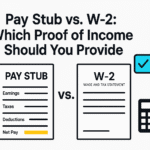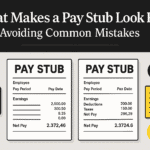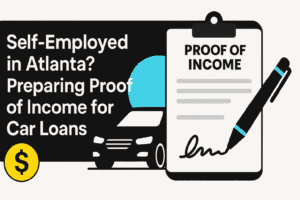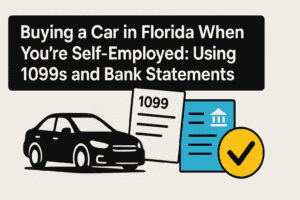Last updated: August 2025
When you apply for car financing, lenders need clear proof that you can repay the loan. The most common way to show affordability is by submitting income documents. Car Loan Pay Stubs often form part of this packet, but they rarely stand alone.
In this guide, we explain whether car loan lenders accept pay stubs in the United States, United Kingdom and Canada. You’ll learn the legal framework for income verification, which edits are lawful, and how to package documents for faster review. Our approach is compliance‑first: we format and organize your genuine records so they’re easy to read—we never change amounts, dates or employers.
Related Entities & Terms
- Pay stub / payslip – earnings statement showing gross wages, taxes, deductions and net pay
- W‑2, 1099‑NEC/1099‑K (US); P60, P45 & SA302 (UK); T4 & Notice of Assessment (NOA, Canada)
- Verification of employment (VOE) and debt‑to‑income (DTI) ratio
- Regulators: CFPB, FTC, IRS (US); FCA & HMRC (UK); FCAC & CRA (Canada)
- Bank statements and deposit verification
- Creditworthiness assessment under FCA CONC and affordability rules
- Proof of income statement (Canada) and “Option C printout”
- Recordkeeping & audit trail (IRS guidelines)
- Car finance products: hire purchase (HP), personal contract purchase (PCP), instalment loans
What are the legal basics of pay stubs for car loans?
Car Loan Pay Stubs are useful, but lenders must verify more than one source. Across jurisdictions, the law demands accurate, independently supported information—not estimates or inflated figures. Below is a high‑level overview of how the rules work in the US, UK and Canada.
United States: documents lenders expect
U.S. lenders use your income to calculate your debt‑to‑income ratio, which shapes both rate and terms. The Consumer Financial Protection Bureau suggests borrowers gather a pay stub from the last 30 days, W‑2s for the prior two years, signed federal tax returns and recent bank statements to streamline underwriting. Preparing this packet in advance reduces back‑and‑forth and prevents errors.
While you don’t need documents to receive a Loan Estimate, a lender may require verification once you proceed with the application. Expect the numbers on your pay stubs to be checked against bank deposits and tax returns. If you have non‑traditional income—tips, gig work or mixed W‑2/1099 earnings—include supporting 1099s, employer letters, or a year‑to‑date profit‑and‑loss to create a consistent picture.
Many underwriters also confirm employment directly. That can include a verbal VOE, an automated payroll pull, or a written confirmation from HR. Presenting clean files with matching names, dates and totals helps these checks move quickly.
United Kingdom: creditworthiness and independent evidence
Under the FCA’s Consumer Credit Sourcebook (CONC), firms must assess creditworthiness before granting a regulated credit agreement. Lenders cannot rely only on your statements; CONC 5.2A notes it is “not generally sufficient to rely solely on a statement of current income made by the borrower without independent evidence”. In practice, that means requesting three months of payslips or P60s, plus bank statements.
Self‑employed applicants typically provide an HMRC SA302 tax calculation and a Tax Year Overview. The UK government confirms many lenders accept tax calculations printed from your online HMRC account. If your income varies because of overtime, commissions or seasonal work, include an explanation and ensure the figures reconcile to deposits.
Affordability assessments also consider fixed commitments like rent and child care. Be ready to show how the new payment fits your budget without causing hardship.
Canada: proof of income statement and lending rights
Canadian lenders often request recent pay stubs and a T4 slip to verify employment income. If you need an official summary, the Canada Revenue Agency issues a proof of income statement commonly used for loans and benefits applications. You can access it through CRA My Account or have it mailed to you.
Because consumer protection is shared between federal and provincial authorities, lenders also follow privacy and fair‑lending rules. Many ask for a Notice of Assessment or three months of bank statements to confirm deposits. Keep everything accurate and consistent; altering a T4 or NOA is unlawful and carries serious penalties.

Which edits are allowed?
Lenders focus on substance, not layout. It is lawful to improve readability and organization, provided you do not change facts or totals. The edits below keep Car Loan Pay Stubs clear while preserving the underlying data.
- Redacting sensitive information. Mask portions of your SSN, account number or home address to protect privacy. Lenders only need enough detail to verify employment and income.
- Improving legibility. If a scan is faint, rotate, crop or raise contrast so figures, pay periods and YTD totals are readable.
- Combining and bookmarking. Merge pay stubs, bank statements and tax forms into one PDF and add bookmarks by document type and month. A short cover sheet can orient the reviewer.
- File conversion and compression. Convert images or spreadsheets to PDF, apply OCR for searchability, and compress files for email—without changing content.
- Annotations and highlights. Use callouts to point to pay period dates, YTD totals or deposit matches. Annotate; don’t overwrite fields.
- Page ordering and numbering. Insert missing pages, fix order, and add page numbers (e.g., “1 of 6”) to signal completeness.
- Consistent naming. Rename files with a clear pattern like 2025‑07‑15_PayStub_EmployerName.pdf so auditors can trace each record.
- De‑duplication. Remove duplicate pages or versions while keeping the most legible copy. Note removals in a cover letter if needed.
- Password management. If statements are password‑protected, share the password separately; do not edit the content to bypass security.
These edits are standard across the US, UK and Canada and help underwriters work faster without compromising integrity.
What changes are illegal?
Any change that misrepresents facts is falsification. Altering numbers, dates, employer names or transactions is fraud, regardless of intent. Below are common illegal edits and why they violate the rules.
- Changing dollar amounts or pay rates. Inflating gross or net pay to qualify for a larger loan is fraudulent. In one case, the FTC sued an auto dealer that allegedly boosted incomes and down payments; staff increased a customer’s monthly income from about $1,200 to $5,200.
- Back‑dating or inventing pay periods. Creating extra pay cycles or shifting dates to simulate longer employment is deceptive and is exposed when deposits do not align.
- Fabricating employers or HR contacts. Fake companies or altered employer details can lead to forgery or identity theft charges.
- Editing tax forms (W‑2, P60, T4, NOA). Tax forms are official records. Altering them violates federal law and may result in fines or imprisonment.
- Manipulating bank statements. Adding deposits, hiding withdrawals or masking NSF fees is illegal. Automated tools often detect inconsistency across files.
- Doctoring employer letters. Modifying an offer letter or VOE to change salary, start date or status crosses the line into fraud.
- Graphic “cleanups” that change figures. Retyping a fuzzy pay stub into a template or “recreating” one from scratch is fabrication, not formatting.
If you are unsure whether an edit is allowed, pause and ask. We will only format authentic records and decline any request that would mislead a lender.
When do you need professional document formatting?
Underwriters make decisions quickly. Clear, consistently labeled files reduce review time and questions. Below are common situations where professional formatting makes a measurable difference.
W‑2 employees and payslip earners
For full‑time or part‑time employees, lenders usually request recent pay stubs and a W‑2 or T4 to verify salary and taxes. The CFPB recommends at least one pay stub covering the last 30 days and two years of W‑2s. In the UK, lenders often require three months of payslips and may cross‑reference them with a P60 or Tax Year Overview. Canadian lenders expect recent pay stubs plus a T4 and may request an NOA.
Professional formatting ensures legibility, page order and full page counts. We can also collate multiple pay periods and add a summary table so reviewers see gross pay, deductions and YTD totals at a glance.
Mini‑scenario: You’re paid semi‑monthly with occasional overtime. We match each pay stub to the corresponding bank deposit, note overtime spikes, and flag any split deposits so the underwriter sees the complete trail.
Self‑employed, gig workers and freelancers
If you receive 1099‑NEC/1099‑K forms (US), run a limited company (UK) or operate as a sole proprietor (Canada), you won’t have a traditional payslip. Lenders rely on tax returns, invoices, business bank statements and a year‑to‑date P&L. In the US, include your latest Schedule C and two years of returns. The IRS reminds taxpayers to keep records long enough to substantiate income and deductions.
In the UK, HMRC’s SA302 and Tax Year Overview are widely accepted. In Canada, a CRA proof of income statement can help summarise earnings. We compile these into a coherent file set, add brief annotations to explain month‑to‑month swings, and reconcile deposits line‑by‑line to reduce follow‑up questions.
Mini‑scenario: You drive for two platforms and receive tips. We label each income stream, include 1099‑Ks where relevant, tie deposits to platform statements, and insert a short cover note explaining weekly variability.
New hires, variable or international income
Just started a job? U.S. lenders may accept an offer letter and your first pay stub; UK lenders may rely on a contract of employment; in Canada, an employer letter confirming salary is common. Pair these with bank statements showing your initial deposits and, if needed, a brief explanation for probationary periods.
If you earn in multiple currencies or from overseas clients, convert amounts to a single currency and draft a short note describing exchange rates and transfer schedules. Professional formatting presents this complexity clearly and preserves the audit trail.
Mini‑scenario: You work remotely for a UK company while living in Canada. We show the CAD equivalents on a separate summary page, reference the date of conversion, and point to the matching deposits in your Canadian account.
Reference internal guides
For more detail on document counts and packaging, see our post on how many pay stubs for a car loan. If you’re unsure whether you’re a contractor or employee, read 1099 contractors vs employees. For rental requirements, compare our guide to common proof of income documents.
How does our process work?
Our service is built for speed, accuracy and compliance. You bring authentic records; we handle formatting and reconciliation so the packet is easy to review. Here’s the process from upload to delivery.
- Intake & consultation. Upload your pay stubs, bank statements, tax documents and letters through our secure portal. We confirm the scope involves legitimate formatting only.
- Reconciliation & audit check. We cross‑check figures across documents—ensuring gross pay, net pay and deposits align and that year‑to‑date totals are consistent. If we see discrepancies, we flag them for clarification before formatting.
- Formatting & redaction. We adjust contrast and orientation, combine documents into a single PDF, add bookmarks and a cover sheet, and redact sensitive information. We follow recordkeeping guidance that files should be complete and easy to read.
- Delivery & support. Within the agreed timeframe (often 24–48 hours), you receive a lender‑ready packet. We keep your files confidential and provide tips on presenting them. Our team remains available for minor tweaks or extra formatting requests.
We will never alter amounts, dates or employer details, and we do not add transactions or fabricate pay periods. If a requested change would cross into falsification, we decline the work and explain why.
Data security note: Use encrypted transfer when possible, avoid emailing passwords in the same message, and keep a local copy of the original files untouched for your records.
Compliance checklist & packaging tips
Use this checklist to assemble a complete, consistent income packet. Tailor it to your country and employment type, and include a brief cover note where context helps.
- Gather the last 30–60 days of pay stubs (US), three months of payslips (UK), or recent pay stubs plus a T4 (Canada).
- Include W‑2 forms (US) or P60/P45 (UK) or NOA/Proof of income statement (Canada) covering the last two years.
- Add your most recent federal tax returns. Keep supporting records long enough to substantiate income and deductions.
- Provide at least two months of bank statements showing payroll deposits and other income sources.
- If self‑employed, include 1099 forms, invoices, a year‑to‑date P&L and, for UK borrowers, SA302 and Tax Year Overviews.
- Use a consistent file format (PDF) and ensure every page is included—even pages marked “intentionally left blank”.
- Redact only sensitive data; do not hide transactions or amounts.
- Add a cover letter explaining employment type, pay frequency and any unusual items (bonuses, tips, overtime, allowances).
- Check that names, addresses, dates, pay periods and totals match across all documents.
- Review for legibility: no blurred scans, misaligned pages or missing signatures.
- Match deposits: tie each pay stub to a bank statement entry and note any split or delayed deposits.
- Confirm employer details: current address, phone and HR contact appear correctly on the pay stub.
- Note variable income: explain seasonality, commissions or tips in two or three clear sentences.
- Standardize filenames: include date, document type and employer (e.g., 2025‑07‑31_PayStub_AcmeCorp.pdf).
- Maintain originals: keep an unedited copy of every document for your records and potential audits.
- If applicable, include proof of residency and ID to reduce follow‑ups.
Following these steps lowers the chance of underwriter callbacks and shows you are organized and transparent.
Common red flags to avoid
Lenders and fraud‑detection systems are trained to spot inconsistencies. Avoid the pitfalls below to keep your application moving smoothly.
- Mismatched numbers. If net pay on the stub does not match the deposit, provide an explanation (split deposits, timing, or deductions).
- Irregular fonts or spacing. Fake stubs often use inconsistent fonts or misaligned columns. Obtain originals from your employer when possible.
- Rounded or repetitive numbers. Identical net pay every period can look suspicious. Real pay varies with taxes and deductions.
- Missing contact information. Ensure the correct company name, address and phone appear so lenders can verify employment.
- Metadata mistakes. PDFs created in form generators rather than employer systems raise questions.
- Lack of a supporting trail. Missing W‑2s, SA302s or bank statements makes verification harder and may trigger a decline.
- Old documents. Stubs older than 60 days (US) or missing a recent payslip run can delay approvals.
- Inconsistent pay frequency. Weekly stubs with semi‑monthly deposits need a note explaining payroll timing.
- Name or address changes unaddressed. If you recently changed names or moved, include documentation so systems match records.
When in doubt, ask us for a quick pre‑check. We’ll flag issues before you submit anything to a lender.
Resources & helpful links
Use these official resources and internal guides to understand document requirements and your rights. They’re a good starting point for packaging Car Loan Pay Stubs and related records.
- CFPB – Create a loan application packet – outlines the documents to gather, including pay stubs, W‑2s, tax returns and bank statements.
- FCA – Consumer Credit Sourcebook (CONC) – explains creditworthiness assessments and the requirement for independent evidence of income.
- CRA – Get a proof of income statement – describes how to obtain a summary of your income for loan applications.
- IRS – Recordkeeping – offers guidance on how long to keep records and why good records support income verification.
- FTC – Car dealers falsified consumers’ income – illustrates the consequences of inflating income on financing forms.
- proof of income editing – our services page explains how we can help format pay stubs, bank statements and tax documents for clarity.
- bank statement formatting – learn about our approach to compressing and organizing bank statements without altering transactions.
- pricing – review our transparent pricing for document editing and packaging.
- contact our team – have questions? Reach out for a confidential consultation.
- about our process – meet our team and learn about our compliance‑first ethos.
FAQs
Do all car loan lenders accept pay stubs as proof of income?
No. While most lenders review pay stubs, they usually require additional verification such as W‑2s, bank statements and tax returns. In the UK, independent evidence is mandatory. Some lenders will accept an employment letter or a proof of income statement if you lack recent stubs, but they still need numbers that can be verified.
How many pay stubs do I need for a car loan?
It varies by lender and location. In the US, many lenders ask for at least one or two stubs covering the last 30–60 days. UK lenders often request three months of payslips. Canadian lenders typically want recent stubs plus a T4 or NOA. For more detail, see our guide on how many pay stubs you need.
What if I’m self‑employed?
Provide tax returns, 1099 forms (US), SA302s (UK) or a CRA proof of income statement (Canada) along with bank statements. Lenders look for consistent earnings and may ask for a year‑to‑date P&L. Good recordkeeping is essential; the IRS notes you must keep records long enough to prove your income and deductions.
Is it legal to edit my pay stubs for clarity?
Yes—formatting and redaction are allowed when used to improve readability or protect privacy. You can crop, adjust contrast, remove sensitive digits and combine documents. You cannot change amounts, dates or employers. Altering factual details is illegal and may constitute fraud.
What happens if I submit fake pay stubs?
Fabricated pay stubs are risky and often detected. Lenders cross‑check income against tax records and bank deposits. If discrepancies appear, your application may be denied and you could face legal action for fraud. In an FTC case, an auto dealer inflated consumers’ incomes, leading to enforcement action. Present accurate documents and shop for a loan that fits your true budget.








Add comment